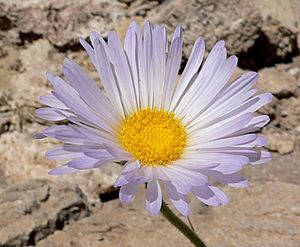Mojave-aster facts for kids
Quick facts for kids Mojave-aster |
|
|---|---|
 |
|
| Scientific classification | |
| Kingdom: | |
| (unranked): | |
| (unranked): | |
| (unranked): | |
| Order: | |
| Family: | |
| Tribe: |
Astereae
|
| Genus: | |
| Species: |
X. tortifolia
|
| Binomial name | |
| Xylorhiza tortifolia (Torr. & A.Gray) Greene
|
|
| Synonyms | |
|
|
The Mojave-aster or Mojave woodyaster (scientific name: Xylorhiza tortifolia) is a beautiful flowering plant. It belongs to the aster family, which is a very large group of plants that includes sunflowers and daisies. This plant is known for its pretty lavender, blue, or white flowers.
Contents
Where Does the Mojave-Aster Live?
The Mojave-aster is a native plant of the southwestern United States and northwestern Mexico. It grows mostly in the dry, hot areas of the Mojave Desert, Sonoran Desert, and Great Basin Desert.
You can find it in rocky canyons and sandy washes, which are dry riverbeds. It grows at different heights, from about 800 feet (240 meters) up to 6,500 feet (2,000 meters) above sea level. This plant likes habitats like creosote bush scrub, saltbush scrub, and Joshua tree woodlands.
What Does the Mojave-Aster Look Like?
The Mojave-aster is a type of plant that can be a perennial herb (meaning it lives for more than two years) or a small subshrub (a plant that is partly woody). Its stems can grow to be about 2 to 2.5 feet (60 to 80 centimeters) long. They are often branched, hairy, and feel a bit sticky because they have glands.
Its leaves can be long and thin (linear), shaped like a spear (lance-shaped), or oval. They often have sharp or spiny tips and spiny edges. The leaves are also hairy and sticky.
How Do Its Flowers Bloom?
The Mojave-aster produces a single flower head at the end of a long stem called a peduncle. The base of the flower head has long, narrow leaf-like parts called phyllaries, which can be more than 0.8 inches (2 centimeters) long.
Each flower head can have up to 60 or more ray florets. These are the "petals" that look like rays coming out from the center. They can be lavender, light blue, or white and grow to be over 1.2 inches (3 centimeters) long. You can see these lovely flowers blooming from March through June.
After the flowers bloom, the plant produces a fruit called an achene. This fruit can be over 0.4 inches (1 centimeter) long, including its pappus, which is a tuft of bristles that helps the seed fly away in the wind.
Different Kinds of Mojave-Aster
There are a few different types, or varieties, of the Mojave-aster:
- Xylorhiza tortifolia var. imberbis: This one is called the Imberis woodyaster. It grows in the Great Basin region, including parts of Nevada, Utah, and Arizona.
- Xylorhiza tortifolia var. parashantensis: Known as the Parashant woodyaster, this variety is only found in Arizona.
- Xylorhiza tortifolia var. tortifolia: This is the most common Mojave aster or Mojave woodyaster. It mainly grows in the higher, colder parts of the Mojave Desert and the Owens Valley in the Great Basin. It can be found from about 800 feet (240 meters) to 6,500 feet (2,000 meters) high.
How People Use the Mojave-Aster
The Havasupai people, a Native American tribe, traditionally used the Mojave-aster. They would grind up the leaves and carry them in their clothes. Both men and women used this as a kind of perfume or incense to smell nice.
Images for kids


